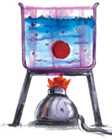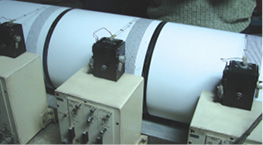Table of Contents

The lithosphere is broken into a number of plates known as the Lithospheric plates. You will be surprised to know that these plates move around very slowly – just a few millimetres each year. This is because of the movement of the molten magma inside the earth. The molten magma inside the earth moves in a circular manner as shown in the activity.
Take a small coloured paper pellet and put it in a beaker half filled with water. Place the beaker on a tripod stand and heat it. As the water warms up, you will observe that the paper pellet is moving upward along with the warm layers of water and then sinks back along with the cooler layers of water. The molten magma inside the earth moves in a similar manner.


Glossary
Lithospheric plates: The earth’s crust consists of several large and some small, rigid, irregularly-shaped plates (slabs) which carry continents and the ocean floor.
The movement of these plates causes changes on the surface of the earth. The earth movements are divided on the basis of the forces which cause them. The forces which act in the interior of the earth are called as Endogenic forces and the forces that work on the surface of the earth are called as Exogenic forces (Fig. 3.1). Endogenic forces sometimes produce sudden movements and at the other times produce slow movements. Sudden movements like earthquakes and volcanoes cause mass destruction over the surface of the earth.

Fig. 3.1: Evolution of Landforms
A volcano is a vent (opening) in the earth’s crust through which molten material erupts suddenly (Fig. 3.2).
Similarly, when the Lithospheric plates move, the surface of the earth vibrates. The vibrations can travel all round the earth. These vibrations are called earthquakes (Fig. 3.3). The place in the crust where the movement starts is called the focus. The place on the surface above the focus is called the epicentre. Vibrations travel outwards from the epicentre as waves. Greatest damage is usually closest to the epicentre and the strength of the earthquake decreases away from
the centre.

Fig. 3.2: A Volcano

Activity
Take a container, fill it with water and close it with a lid. Put the water to boil. Now put some peas, spoon and beads on top on the lid. What do you notice? As the water boils the lid begins to shake. The things which you have put on the lid also vibrate. The beads roll down and the spoon vibrates to make a sound. In the same manner, the earth vibrates when an earthquake occurs.
Do you Know
There are three types of earthquake waves:
1. P waves or longitudinal waves
2. S waves or transverse waves
3. L waves or surface waves
Try to find out the properties of these waves from an encyclopedia.
Although earthquakes cannot be predicted, the impact can certainly be minimised if we are prepared before-hand.

Fig. 3.3: Origin of an Earthquake
.
Some common earthquake prediction methods adopted locally by people include studying animal behaviour; fish in the ponds get agitated, snakes come to the surface.

Fig. 3.3a: Destruction caused by an Earthquake in Gujarat
An earthquake is measured with a machine called a seismograph. The magnitude of the earthquake is measured on the Richter scale. An earthquake of 2.0 or less can be felt only a little. An earthquake over 5.0 can cause damage from things falling. A 6.0 or higher magnitude is considered very strong and 7.0 is classified as a major earthquake.

A Seismograph
Earthquake – A Case Study

Activity
1. Read the ‘Earthquake – A case study’ given in the form of headlines that appeared in the newspapers after the quake. Arrange the events in the right sequence of their happening.
2. Imagine if a quake suddenly shook in the middle of the school day, where would you go for safety?
Earthquake Preparedness
Where to take shelter during an earthquake —
Safe Spot – Under a kitchen counter, table or desk, against an inside corner or wall.
Stay Away from – Fire places, areas around chimneys, windows that shatter including mirrors and picture frames.
Be Prepared – Spread awareness amongst your friends and family members and face any disaster confidently.
Major Land Forms
The landscape is being continuously worn away by two processes – weathering and erosion. Weathering is the breaking up of the rocks on the earth’s surface. Erosion is the wearing away of the landscape by different agents like water, wind and ice. The eroded material is carried away or transported by water, wind, etc. and eventually deposited. This process of erosion and deposition create different landforms on the surface of the earth.
Work of a River
• There are thousands of small waterfalls in the world. The highest waterfall is Angel Falls of Venezuela in South America. The other waterfalls are Niagara falls located on the border between Canada and USA in North America and Victoria Falls on the borders of Zambia and Zimbabwe in Africa.

The Niagra falls

Fig. 3.4: Waterfall
As the river enters the plain it twists and turns forming large bends known as meanders. Due to continuous erosion and deposition along the sides of the meander, the ends of the meander loop come closer and closer. In due course of time the meander loop cuts off from the river and forms a cut-off lake, also called an ox-bow lake. At times the river overflows its banks. This leads to the flooding of the neighbouring areas. As it floods, it deposits layers of fine soil and other material called sediments along its banks. This leads to the formation of a flat fertile floodplain. The raised banks are called levees. As the river approaches the sea, the speed of the flowing water decreases and the river begins to break up into a number of streams called distributaries. The river becomes so slow that it begins to deposit its load. Each distributary forms its own mouth. The collection of sediments from all the mouths forms a delta.

Fig. 3.5: Features made by a river in a flood plain
Let's do
Find out the names of a few rivers of the world that form a delta.

Fig. 3.6: A Delta
Work of Sea Waves
The erosion and deposition of the sea waves gives rise to coastal landforms. Seawaves continuously strike at the rocks. Cracks develop. Over time they become larger and wider. Thus, hollow like caves are formed on the rocks. They are called sea caves. As these cavities become bigger and bigger only the roof of the caves remain, thus forming sea arches. Further, erosion breaks the roof and only walls are left. These wall like features are called stacks. The steep rocky coast rising almost vertically above sea water is called sea cliff. The sea waves deposit sediments along the shores forming beaches.

Fig. 3.7: Features made by sea waves
Work of Ice
Glaciers are “rivers of ice” which too erode the landscape by bulldozing soil and stones to expose the solid rock below. Glaciers carve out deep hollows there. As the ice melts they get filled up with water and become beautiful lakes in the mountains. The material carried by the glacier such as rocks big and small, sand and silt gets deposited. These deposits form glacial moraines.

Fig. 3.8: A Glacier
Work of wind
Have you ever visited a desert? Try to collect some pictures of sand dunes

Fig. 3.9: Sand Dunes
An active agent of erosion and deposition in the deserts is wind. In deserts you can see rocks in the shape of a mushroom, commonly called mushroom rocks. Winds erode the lower section of the rock more than the upper part. Therefore, such rocks have narrower base and wider top. When the wind blows, it lifts and transports sand from one place to another. When it stops blowing the sand falls and gets deposited in low hill – like structures. These are called sand dunes (Fig. 3.9). When the grains of sand are very fine and light, the wind can carry it over very long distances. When such sand is deposited in large areas, it is called loess. Large deposits of loess is found in China.

1. Answer the following questions.
(i) Why do the plates move?
(ii) What are exogenic and endogenic forces?
(iii) What is erosion?
(iv) How are flood plains formed?
(v) What are sand dunes?
(vi) How are beaches formed?
(vii) What are ox bow lakes?
2. Tick the correct answer.
(i) Which is not an erosional feature of sea waves?
(a) Cliff (b) Beach (c) Sea cave
(ii) The depositional feature of a glacier is:
(a) Flood plain (b) Beach (c) Moraine
(iii) Which is caused by the sudden movements of the earth?
(a) Volcano (b) Folding (c) Flood plain
(iv) Mushroom rocks are found in:
(a) Deserts (b) River valleys (c) Glaciers
(v) Ox bow lakes are found in:
(a) Glaciers (b) River valleys (c) Deserts
3. Match the following.
(i) Glacier (a) Sea shore
(ii) Meanders (b) Mushroom rock
(iii) Beach (c) River of ice
(iv) Sand dunes (d) Rivers
(v) Waterfall (e) Vibrations of earth
(vi) Earthquake (f) Sea cliff
(g) Hard bed rock
(h) Deserts
4. Give reasons.
(i) Some rocks have a shape of a mushroom.
(ii) Flood plains are very fertile.
(iii) Sea caves are turned into stacks.
(iv) Buildings collapse due to earthquakes.
5. Activity.
Observe the photographs given below. These are various features made by a river. Identify them and also tell whether they are erosional or depositional or landforms formed by both.

6. For fun.
Solve the crossword puzzle with the help of given clues.

Across
2. Loop like the bend of a river
4. Solid form of water
7. Moving mass of ice
9. Sudden descent of water in the bed of a river
11. Natural cavity on weak rocks formed by action of waves
12. Embankment on a river that keeps it in its channel
13. Large body of sea water
14. Dry area where sand dunes are found
15. Small hill of sand caused by the action of the wind
16. Flat plain formed by river deposits during time of flood
Down
1. Rise and fall of water caused by friction of wind on water surface
3. Flow of water in a channel
5. Steep perpendicular face of a rock along a sea coast
6. Debris of boulder and coarse material carried by glacier
8. Crescent shaped lake formed by a meandering river
10. Fine sand deposited by the action of the wind
13. Isolated mass of rising steep rock near a coastline
14. Alluvial tracts of land formed by the river deposits at the mouth of a river
